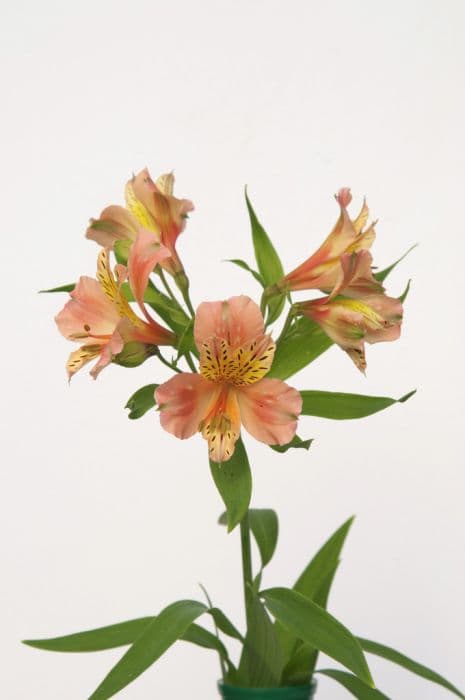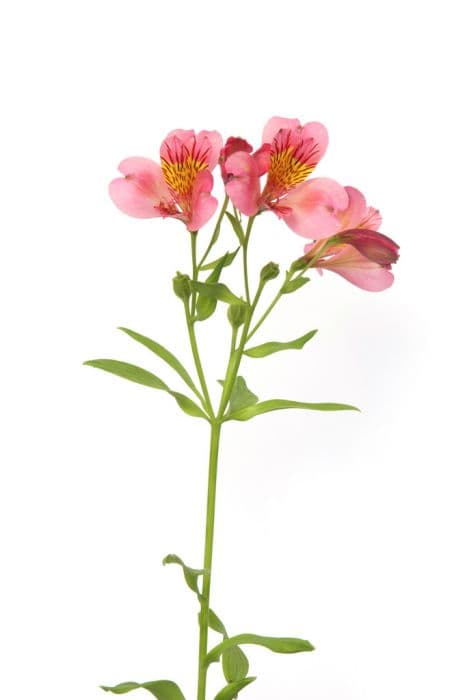Peruvian Lily Alstroemeria 'Cahors' (Planet Series)

ABOUT
The Alstroemeria 'Cahors' from the Planet Series, commonly known as Peruvian Lily or Lily of the Incas, presents a striking appearance with its vibrant flowers and lush foliage. The flowers are a blend of deep plum and burgundy hues, with each petal exhibiting intricate flecks and streaks of a paler yellow to cream, accentuating the depth of color and adding to the plant's eye-catching aesthetic. The petals are typically arranged in a symmetrical fashion, with three slightly larger petals alternating with three smaller ones, all converging to form a trumpet-like shape that is characteristic of Peruvian Lilies. These blossoms form in clusters atop the slender, green stems, emerging amidst lance-shaped leaves that are a rich green color. The leaves themselves may appear whorled around the stem, providing a lush and full backdrop for the vivid floral display. The overall impression of Alstroemeria 'Cahors' is one of exotic vibrancy and dramatic flair, making it a popular choice for gardeners looking to add a touch of sophistication and lasting color to their garden displays. The plant is prized for its long-lasting flowers, which are often cut and used in floral arrangements due to their beauty and longevity.
About this plant
 Names
NamesFamily
Alstroemeriaceae.
Synonyms
Peruvian Lily, Lily of the Incas, Parrot Lily.
Common names
Alstroemeria 'Cahors'
 Toxicity
ToxicityTo humans
The Peruvian lily, which includes the Alstroemeria 'Cahors', is not considered highly toxic to humans. However, it may cause mild irritation if ingested. The symptoms can include nausea, vomiting, or diarrhea. Skin contact with the sap can sometimes lead to dermatitis or skin irritation. It is advisable to handle the plant with care and to avoid ingestion of any part of the plant to prevent any potential adverse effects.
To pets
The Peruvian lily, or Alstroemeria 'Cahors', is considered mildly toxic to pets, such as cats and dogs. If ingested, it may cause mild gastrointestinal upset, which can include symptoms like vomiting or diarrhea. It is best to keep this plant out of reach of pets to avoid any discomfort or health issues they might experience after chewing on or consuming any part of the plant.
 Characteristics
CharacteristicsLife cycle
Perennials
Foliage type
Deciduous
Color of leaves
Green
Flower color
Mixed
Height
2-3 feet (60-90 cm)
Spread
1-2 feet (30-60 cm)
Plant type
Bulb
Hardiness zones
7
Native area
South America
Benefits
 General Benefits
General Benefits- Long-lasting blooms: Alstroemeria 'Cahors' is known for its long flowering season, providing vibrant colors for an extended period.
- Attracts pollinators: The flowers of Alstroemeria 'Cahors' attract bees, butterflies, and other beneficial insects to the garden.
- Versatile use: The cut flowers are widely used in floral arrangements and bouquets due to their beauty and longevity after cutting.
- Drought-tolerant: Once established, Alstroemeria 'Cahors' has a good level of drought tolerance, requiring less frequent watering.
- Easy to grow: This plant is relatively easy to care for, making it a good choice for both experienced and novice gardeners.
- Vibrant colors: The Peruvian Lily comes in a variety of bright and appealing colors that can brighten up any garden space.
- Compact habit: The 'Cahors' variety, being part of the Planet Series, has a compact growth habit, making it suitable for smaller gardens or container growing.
 Medical Properties
Medical PropertiesThis plant is not used for medical purposes.
 Air-purifying Qualities
Air-purifying QualitiesThis plant is not specifically known for air purifying qualities.
 Other Uses
Other Uses- Photography Prop: Alstroemeria makes for a vibrant and detailed subject in macro photography, allowing photographers to capture the intricate patterns and colors of the flowers.
- Eco-Friendly Confetti: Dried Alstroemeria petals can be used as natural, biodegradable confetti for weddings or celebrations, reducing environmental impact.
- Crafting Material: The sturdy yet beautiful petals of the Alstroemeria can be used in crafting, such as making homemade greeting cards or bookmarks.
- Edible Garnish: While not widely known for its edibility, Alstroemeria petals can be used as an edible garnish for desserts and salads after ensuring they are free from pesticides.
- Color Inspiration: Alstroemeria's vibrant colors can inspire artists and designers for color palettes in their visual works or interior design projects.
- Nature Journaling: The flowers of the Alstroemeria can be pressed and included in nature journals or herbariums as a record of plant life in a particular region.
- Fashion Accessories: Small Alstroemeria blooms can be incorporated into fashion accessories such as hairpins, brooches, or corsages.
- Homemade Potpourri: Dried Alstroemeria flowers can be part of a homemade potpourri mix, creating natural room fragrances when combined with other scented botanicals.
- Floral Watercoloring: The intricate patterns of Alstroemeria flowers make them an excellent subject for watercolor artists to practice and showcase their skills.
- Teaching Tool: in botany education, Alstroemeria can be used to teach about the unique pollination mechanisms and flower structures.
Interesting Facts
 Feng Shui
Feng ShuiThe Peruvian Lily is not used in Feng Shui practice.
 Zodiac Sign Compitability
Zodiac Sign CompitabilityThe Peruvian Lily is not used in astrology practice.
 Plant Symbolism
Plant Symbolism- Friendship: Alstroemeria, also known as Peruvian Lily or Lily of the Incas, often symbolizes strong bonds of friendship due to its clusters of blooms representing the interconnected nature of relationships.
- Devotion and Loyalty: The twists in the flower which cause it to turn upside down and the leaves to grow upside down are interpreted as the ups and downs in friendships, symbolizing the steadfastness and support through good times and bad.
- Wealth, Prosperity, and Fortune: Because of the Peruvian Lily's vibrant and colorful appearance, it's often associated with wealth and the idea of bringing positive energy that could lead to prosperity.
- Mutual Support: As the Alstroemeria grows, its stems support each other, which symbolizes mutual support between people, suggesting a relationship where both individuals help each other to succeed.
- Achieving Aspirations: The Alstroemeria 'Cahors' can also represent the pursuit and achievement of one's personal aspirations and the encouragement one receives from their friends to fulfill their dreams.
 Water
WaterThe Peruvian Lily should be watered regularly to maintain moist but not soggy soil; it's important not to let the soil dry out completely. During the growing season in spring and summer, water about once a week, using approximately one gallon per plant each time, depending on the climate and weather conditions. In winter, reduce watering to every two weeks or less, just enough to prevent the soil from drying out completely. Monitor the plant's response and adjust your watering schedule accordingly to avoid overwatering, which can lead to root rot.
 Light
LightPeruvian Lilies thrive in bright indirect light; they prefer a spot that receives full sun to partial shade. The ideal location would avoid the harsh midday sun, which can scorch their leaves, so placing them in a position where they receive morning sunlight and afternoon shade is optimal. A south-facing or west-facing window with a sheer curtain would be suitable for indoor plants to filter the intensity of direct sunlight.
 Temperature
TemperaturePeruvian Lilies can survive in a temperature range of roughly 40 to 80 degrees Fahrenheit, but they flourish best in moderate temperatures between 65 and 75 degrees Fahrenheit. They can tolerate a mild frost, but prolonged exposure to temperatures below 40 degrees can damage or kill the plant. Protect the Peruvian Lily from extreme temperature fluctuations and consider mulching to provide insulation during colder months.
 Pruning
PruningPruning is essential for encouraging bushier growth and more flowers in Peruvian Lilies. Prune lightly after the main blooming season to shape the plant and remove any dead or damaged stems. Intensive pruning is best done in late winter or early spring before new growth starts. This can invigorate the plant by promoting fresh growth and larger blooms. Always use clean, sharp tools to make precise cuts and avoid damaging the plant.
 Cleaning
CleaningAs needed
 Soil
SoilPeruvian lily 'Cahors' thrives in fertile, well-drained soil with a pH of 6.0 to 7.0. The best soil mix for this plant would contain equal parts of loam, sand, and peat to ensure good drainage and fertility. Regularly adding organic matter will also benefit the soil condition and plant health.
 Repotting
RepottingPeruvian lilies should be repotted every 2 to 3 years to replenish the soil and give the roots new room to grow. Larger clumps can be divided during repotting to propagate or control the plant's size. It is best to repot in the spring when the plant shows signs of new growth.
 Humidity & Misting
Humidity & MistingPeruvian lily 'Cahors' prefers moderate to high humidity levels. The best range is around 40-60% relative humidity, which can be maintained indoors with the use of a humidifier or by placing a water tray near the plant. Avoid placing it in drafty areas where humidity levels could drop too low.
 Suitable locations
Suitable locationsIndoor
Bright indirect light, moderate watering, and good drainage.
Outdoor
Full sun to partial shade, well-draining soil, and regular watering.
Hardiness zone
7-10 USDA
 Life cycle
Life cycleAlstroemeria 'Cahors', commonly known as Peruvian Lily or Lily of the Incas from the Planet Series, starts its life cycle when seeds germinate or rhizomes sprout in early spring, under the right temperature and soil conditions. After sprouting, the plant develops into a vegetative state, producing long, slender leaves and robust stems. As it matures, the Alstroemeria 'Cahors' enters the flowering stage, typically in late spring to early summer, where it produces its distinctive trumpet-shaped, colorful flowers that attract pollinators. Once pollinated, the flowers will develop seed pods, and when the seeds are mature, they are dispersed to the surrounding area, repeating the cycle. During the autumn or in response to short days and cooler temperatures, the Alstroemeria 'Cahors' will enter a period of dormancy, conserving energy by dying back to the ground. With the return of warmer spring weather, the plant will regenerate from its rhizomes, starting the cycle anew.
 Propogation
PropogationPropogation time
Spring-Early Summer
Alstroemeria 'Cahors', commonly referred to as Peruvian Lily or Lily of the Incas, is most effectively propagated through division, which is best done in the spring. To propagate by division, carefully lift the clump of tubers from the ground using a garden fork, being mindful not to damage the tubers. Gently separate the tubers by hand, ensuring each division has at least one growth shoot. Replant the divisions immediately, placing them about 6 to 8 inches (15 to 20 centimeters) deep and spacing them around 12 to 24 inches (30 to 60 centimeters) apart to give room for growth. It's vital to keep the soil moist after planting to help the new divisions establish.



![Peruvian lily [Indian summer]](/_next/image?url=https%3A%2F%2Fplants-admin.emdemapps.com%2Fimages%2Fplants%2F%2Fimages%2F604b616bc746b.png&w=640&q=75)
![Peruvian lily [Inticancha Creamy Dark Pink]](/_next/image?url=https%3A%2F%2Fplants-admin.emdemapps.com%2Fimages%2Fplants%2F%2Fimages%2F604b5e98bea7c.png&w=640&q=75)
![Peruvian lily [Inticancha Imala]](/_next/image?url=https%3A%2F%2Fplants-admin.emdemapps.com%2Fimages%2Fplants%2F%2Fimages%2F604b619b522ba.png&w=640&q=75)
![Peruvian lily [Inticancha Red]](/_next/image?url=https%3A%2F%2Fplants-admin.emdemapps.com%2Fimages%2Fplants%2F%2Fimages%2F604b5aebac273.png&w=640&q=75)
![Peruvian lily [Inticancha Sunday]](/_next/image?url=https%3A%2F%2Fplants-admin.emdemapps.com%2Fimages%2Fplants%2F%2Fimages%2F604b646146dd9.png&w=640&q=75)

